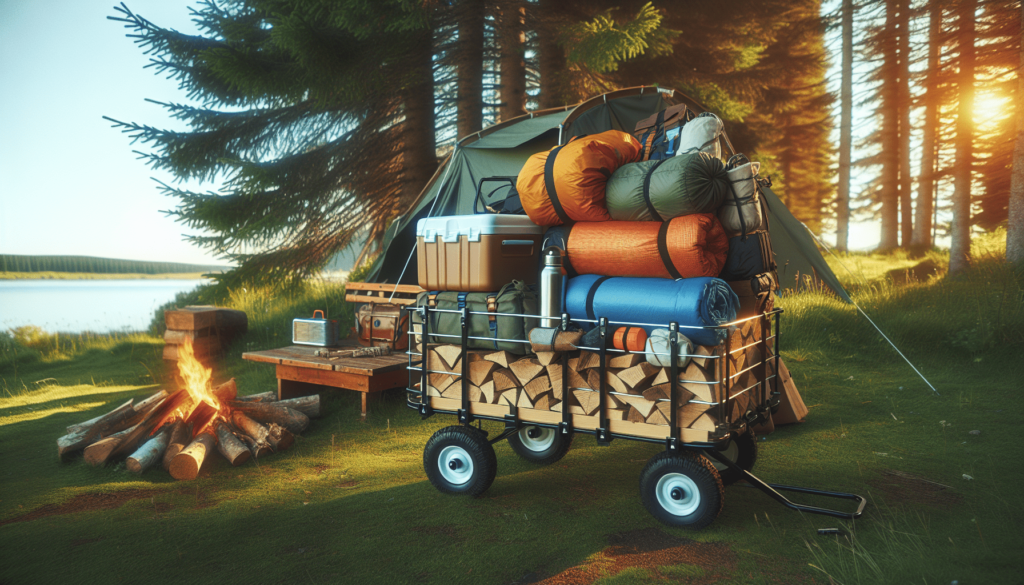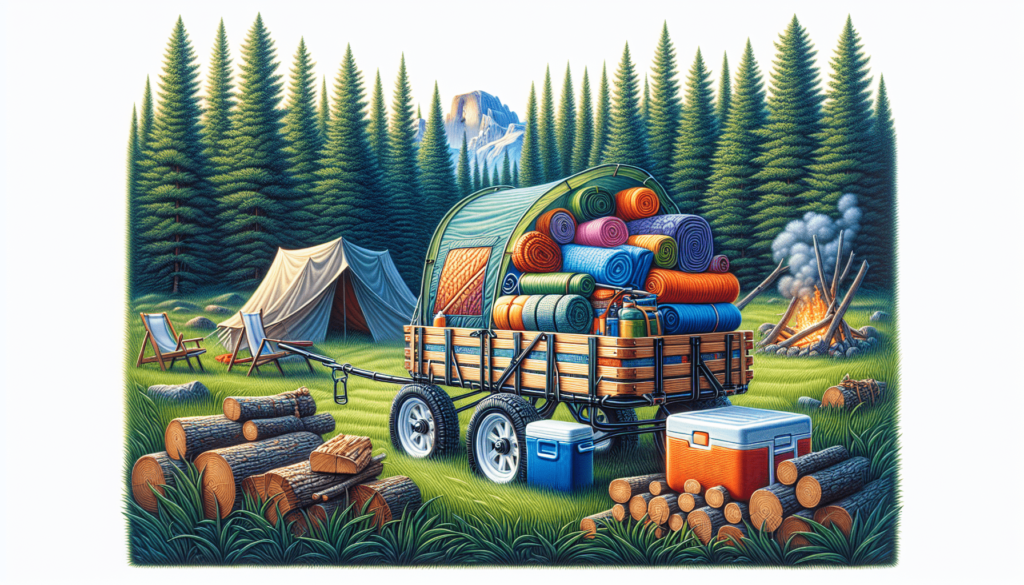Have you ever found yourself wondering how to efficiently pack your folding wagon for a weekend camping trip? It’s a common puzzle that every outdoor enthusiast faces, and getting it right can make your experience so much more enjoyable. The last thing you want is to arrive at your campsite only to realize that you forgot essential gear or that you’ve packed in a way that makes everything a hassle to access. So, let’s break this down together.

Understanding Your Folding Wagon
Before we get into the packing process, let’s take a moment to appreciate your trusty folding wagon. This versatile piece of gear can carry a variety of camping supplies, from food and water to sleeping bags and gear. Its design not only makes it lightweight and portable, but also incredibly easy to set up and use.
Benefits of Using a Folding Wagon
Using a folding wagon for camping offers several advantages:
- Mobility: You can navigate various terrains with ease, making it a breeze to transport your gear from the car to the campsite.
- Storage: It can hold a substantial amount of equipment, keeping your hands free for other tasks, like navigating trails or holding onto your pup’s leash.
- Durability: Most folding wagons are built to withstand the rigors of outdoor use, so you can depend on it to carry your gear without falling apart.
Understanding how to best utilize that mobility and storage is key to having a successful trip.
Organizing Your Gear
Now that you recognize the advantages of your folding wagon, let’s talk about how to organize all your gear effectively.
Inventory Checklist
First things first, create an inventory checklist of essentials you’ll need for your camping trip. Below is a simple table to help you categorize your items:
| Category | Items |
|---|---|
| Sleeping Gear | Tent, sleeping bags, pillows |
| Cooking Supplies | Stove, utensils, cooler, food |
| Clothing | Weather-appropriate layers, rain gear |
| Personal Items | Toiletries, first aid kit |
| Entertainment | Books, cards, games |
| Miscellaneous | Blanket, portable chairs, flashlight |
Prioritizing Essentials
Take a close look at your checklist and prioritize items based on necessity. Sleeping gear and cooking supplies usually top the list, followed by clothing and personal items. By aligning your packing order with these priorities, you can access essentials quickly, which is especially handy if you arrive at your campsite late.
Packing Techniques
Once you have everything on your checklist, it’s time to unpack the finer skills of packing your folding wagon.
Layering Your Gear
To maximize space, work with layering techniques. The heaviest items should go to the bottom to create a stable base. Here’s a simple sequence:
- Heavy Items: Start with your sleeping bags and tent. Lay them flat and even to establish a sturdy foundation.
- Cooking Supplies: Next, stack your cooler and cooking stove. If possible, place the cooler on top of larger items that won’t get crushed.
- Clothing and Personal Items: Use soft items, like clothing, for cushioning between hard items.
- Entertainment and Miscellaneous: These can fill leftover gaps in your packing. A deck of cards or a portable chair can easily fit into small spaces.
Utilizing Space Wisely
Be creative with the space you have. Here are some tips:
- Compress Bags: For your sleeping gear, use compression bags to minimize their size and fit them snugly.
- Use Containers: Put smaller items in containers that slide into tight spots. For example, a first-aid kit can easily fit in the cooler’s empty spaces.
- Take Advantage of Side Pockets: If your wagon has side pockets, use them for quick-access items like snacks or water bottles.

Arranging Items for Easy Access
What good is packing if you don’t have easy access to your gear? Ensuring that everything is within reach when you arrive at your campsite will save you time and keep frustration at bay.
Quick Access Items
Consider leaving out items that you’ll need upon arrival. This can include:
- Flashlights for when the sun sets.
- Snacks to munch on while setting up camp.
- Your first-aid kit, in case of accidents during setup.
Create Zones
It’s beneficial to create zones in your wagon:
- Dining Zone: All cooking and food items keep together.
- Sleeping Zone: Organize sleeping gear neatly in its section.
- Activity Zone: Place entertainment items and outdoor games nearby.
Organizing these zones helps you find what you need without digging through everything, keeping the process smooth and efficient.
Safeguarding Your Gear
You’ve packed efficiently; now let’s protect everything you brought along on your trip.
Using Tarps or Covers
Depending on the weather forecast, a tarp can give your gear added protection against rain or dew. Covering your wagon not only shields your items but also keeps them dry, even if the weather surprises you.
Securing with Bungee Cords
If your wagon has an open design, secure your gear with bungee cords. This minimizes the chance of items spilling out during transport. Simply loop them around large gear to keep everything snugly secured.
Before You Hit the Road
With your wagon packed and secured, it’s time to double-check your preparation before setting off to your weekend adventure.
Take a Moment for a Final Check
Before leaving, consider going through your checklist one last time. Ensure all essentials have made it to the wagon, including:
- Directions to your campsite
- Confirmation of any reservations, if needed
- A fully charged phone or GPS device
Adjust to Loading Your Vehicle
When it’s time to put your wagon in your vehicle, keep in mind the order of items based on how you’ll be unpacking at the campsite. Place items you’ll need first on top or in easy reach.
Setting Up Camp
You’ve arrived at your campsite, and your wagon has served you well. Now let’s talk about what comes next.
Unloading Efficiently
When unloading, stick to the same zones you established while packing. Start with the dining zone, set up your cooking area, and prepare to keep things organized. For outdoor cooking, create a space where food preparation can happen efficiently and away from the sleeping areas.
Setting Up the Sleeping Area
Next, move to create your sleeping zone. With your organized sleeping gear, making your sleeping area cozy will only take moments. Unroll your sleeping bags and set up your tent, and feel free to personalize it with any extra blankets or pillows.
Embracing the Camping Experience
You’ve made it! By packing effectively, you’ve paved the way for a memorable and enjoyable weekend camping experience.
Enjoying Activities
With all your gear set up and accessible, take the time to soak in the beauty surrounding you. Whether it’s hiking, fishing, or simply relaxing with your favorite book, embrace each moment.
Cooking and Dining Under the Stars
At the end of a day filled with adventure, gather around your campsite for a lovely meal. Cooking outdoors can enhance the experience even more.
Tips for Future Trips
Now that you’ve tackled your first packing adventure, what will you remember for next time?
Reflect on What Worked
After your camping trip, think about what packing strategies worked well and what could be improved. Maybe you realized certain items didn’t make the trip, while others became essential. Adjust your checklist accordingly for greater efficiency on your next adventure.
Lessons Learned
Consider journaling your camping experiences. Writing down what worked, what didn’t, and any surprises can be beneficial for your future trips. A log of your favorite campsites and activities will also satisfy nostalgia and help you plan similar outings in the future.
Final Thoughts
Packing your folding wagon for a weekend camping trip is not just about how much you can fit into it; it’s about understanding your needs and organizing efficiently. Once you’ve nabbed the packing process down to an art, every camping trip will become smoother and more enjoyable.
So, as you gear up for your next adventure, remember to pack thoughtfully, prioritize essentials, and cherish every moment in nature. You’ll create beautiful memories while staying organized and efficient. Happy camping!

